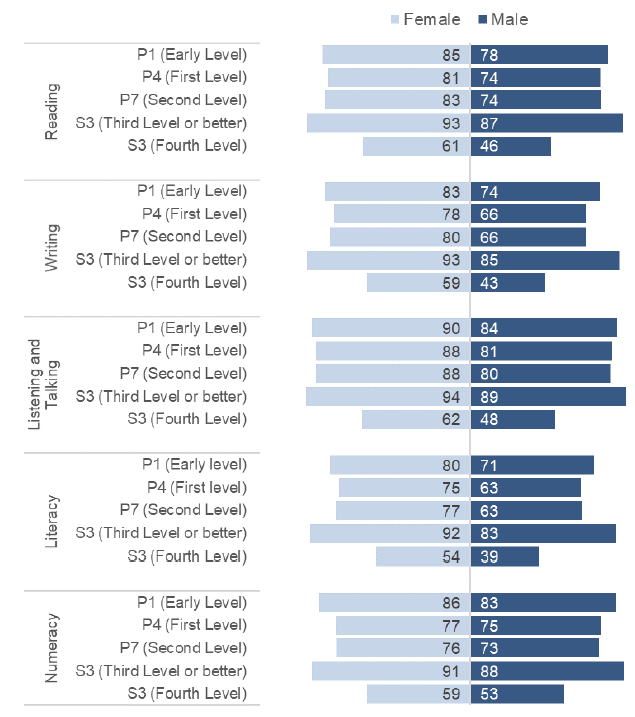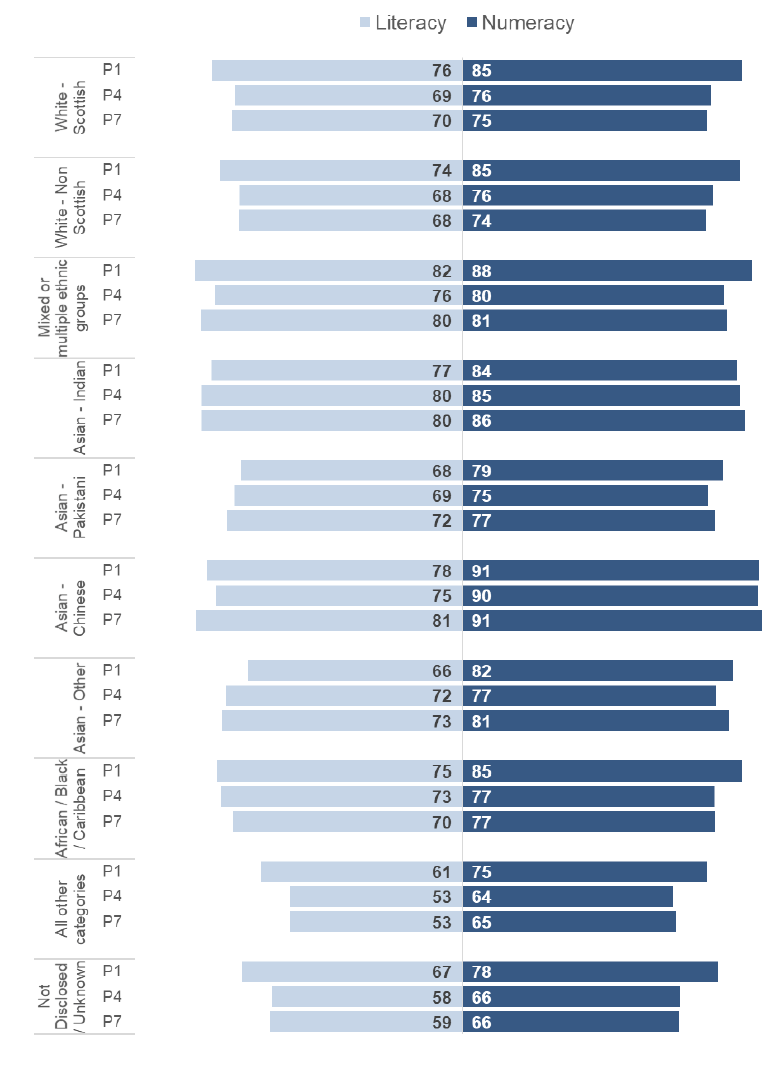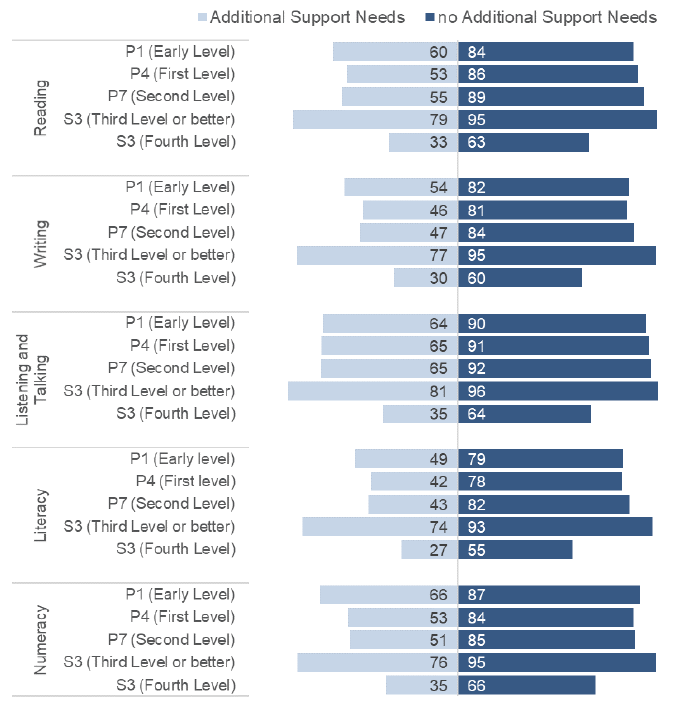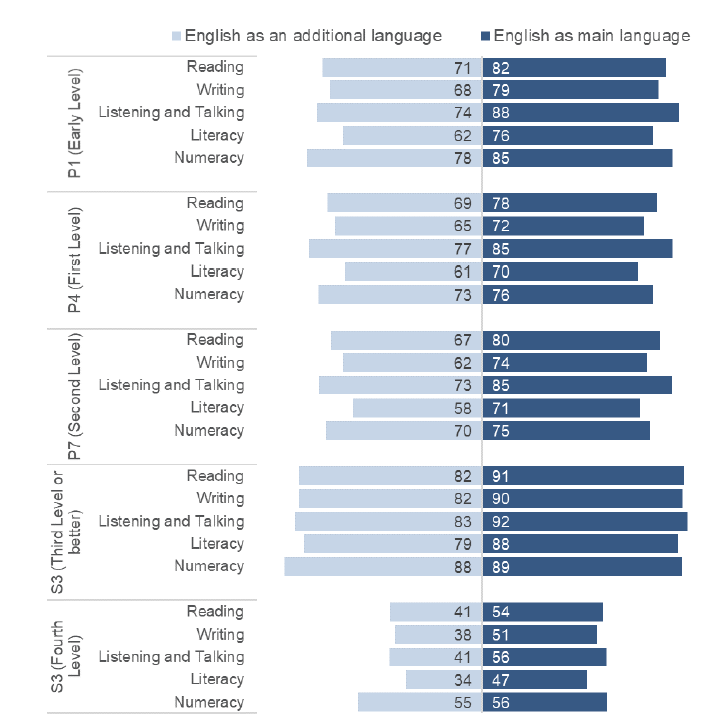Achievement of Curriculum for Excellence (CfE) Levels 2017-18
This contains the results of the achievement of curriculum for excellence (CFE) levels 2017/2018.
This document is part of a collection
Chapter 4: Achievement of CfE levels by pupil characteristics
- Female pupils outperform male pupils across all stages and organisers.
- Pupils who have an Additional Support Need or English as an Additional Language tend to perform lower than pupils without those characteristics, in all stages and organisers.
- A higher percentage of pupils of Asian – Chinese ethnic background are achieving the expected CfE levels in numeracy compared to pupils of other ethnic backgrounds.
- The percentage of P1 pupils achieving the expected level for their stage was highest for pupils living in accessible rural areas. At P4, performance was highest for pupils from either large urban areas or accessible small towns. In P7 performance was generally higher for pupils from large urban areas and accessible rural areas.
4.1 Achievement of CfE levels by gender
At all stages and across all four organisers, females outperformed males, particularly in writing; this has been consistent in the three years of this data collection.
The largest difference in performance at primary was in writing in P7 at 14 percentage points. The smallest difference for the literacy organisers was in reading for P1, at six percentage points.
For S3 (Third Level or better), the largest difference in performance between males and females was in writing at eight percentage points; whereas the smallest was in listening and talking at five percentage points, for the literacy organisers (Chart 4.1.1).
The smallest difference in performance by gender was in numeracy. Females outperformed males but by a smaller margin; three percentage points at P1, P7 and S3 (Third Level or better) and by two percentage points in P4.
The gap in literacy performance by gender increases through the primary stages at 10, 12 and 14 percentage points for the P1, P4 and P7 stages respectively.
With respect to S3 pupils achieving Fourth Level, the pattern was the same in that the smallest difference was in numeracy and the largest was in writing.
Chart 4.1.1 Percentage of pupils achieving expected CfE levels, by gender and stage, 2017/18

4.2 Achievement of CfE levels by ethnicity
The largest ethnic group represented in these data was White-Scottish (ranging from 73 to 84 per cent across the stages in question), followed by White non-Scottish (ranging from nine to 13 per cent). Pupils of an Asian – Pakistani background represented around two per cent of the pupil population of interest, and the remaining ethnic groups made up around about one per cent of the population (each).
Performance was highest for pupils of an Asian – Chinese background in numeracy, with results around 90 per cent across all primary stages, rising to 98 per cent at S3. This has been consistent in the three years of this data collection.
Chart 4.2.1 shows performance in literacy and numeracy for each primary stage. Performance by ethnic group varies by stage. Performance in literacy was highest for pupils from Mixed and Multiple ethnic background at P1 (82 per cent), pupils from Asian – Indian background at P4 (80 per cent) and pupils from Asian – Chinese background at P7 (81 per cent).
Chart 4.2.1 - Percentage of P1, P4 and P7 pupils achieving literacy and numeracy CfE levels, by ethnicity and stage, 2017/18

Table 4.2.1: Percentage of S3 pupils achieving Third Level or better by ethnicity, 2017/18
| Stage/Level | Reading | Writing | Listening & Talking | Literacy | Numeracy |
|---|---|---|---|---|---|
| White - Scottish | 90 | 89 | 91 | 88 | 89 |
| White - Non Scottish | 88 | 87 | 89 | 85 | 89 |
| Mixed or multiple ethnic groups | 93 | 92 | 94 | 91 | 92 |
| Asian - Indian | 92 | 93 | 95 | 92 | 95 |
| Asian - Pakistani | 93 | 94 | 94 | 92 | 93 |
| Asian - Chinese | 98 | 97 | 96 | 95 | 98 |
| Asian - Other | 90 | 90 | 91 | 88 | 92 |
| African / Black / Caribbean | 93 | 91 | 94 | 90 | 93 |
| All other categories | 73 | 74 | 76 | 71 | 84 |
| Not Disclosed / Unknown | 81 | 80 | 82 | 78 | 84 |
| All pupils | 90 | 89 | 91 | 87 | 89 |
At S3, performance was highest for pupils of an Asian – Chinese background across all four organisers (Table 4.2.1). With respect to the three literacy organisers, performance of White – Non Scottish pupils and pupils in the ‘All other categories’ and ‘Not disclosed/Unknown’ categories was lower than the national average. In numeracy, pupils in the ‘All other categories’ and ‘Not disclosed/Unknown’ categories saw the lowest performance with 84 per cent achieving the expected CfE levels, compared to the national average of 89 per cent.
4.3 Achievement of CfE levels by Additional Support Need (ASN) status
The percentage of pupils in the Achievement of CfE Levels data collection that were recorded as having an Additional Support Need increased throughout the stages: 11, 25, 30 and 31 per cent for P1, P4, P7 and S3 respectively.
The percentage of pupils achieving the expected CfE level was higher for pupils recorded as not having an Additional Support Need (ASN), compared to pupils with a known ASN, across all stages and organisers. The difference in performance was lowest in P1 for numeracy (21 percentage points), listening and talking at P4 (26 percentage points) and listening and talking at P7 (27 percentage points).
Chart 4.3.1 Percentage of pupils achieving CfE levels, by additional support needs and stage, 2017/18

At P1, P4 and P7, the greatest difference in performance (between pupils with a recorded ASN and pupils with no recorded ASN) was in writing, with differences of 27, 35 and 38 percentage points respectively.
At S3 (Third Level or better), the lowest percentage point difference was in listening and talking (14 percentage points), with 96 per cent of pupils with no ASN achieving the expected level, compared to 81 per cent of pupils with a recorded ASN.
4.4 Achievement of CfE levels by English as an Additional Language (EAL) status
The percentage of pupils, in this data collection, who have English as an additional language (EAL) was between five to eight per cent in 2017/18 for pupils in P1, P4, P7 and S3.
The percentage of pupils achieving the expected CfE level was higher for non-EAL pupils across all stages and organisers (Chart 4.4.1). The gap in performance tended to be lowest in numeracy; ranging from one percentage point for S3 pupils to seven percentage points for P1 pupils.
Chart 4.4.1: Percentage of pupils achieving expected CfE levels, by English as an additional language and stage, 2017/18

EAL pupils performed better in listening and talking, compared to the other literacy organisers at all three primary stages (74, 77 and 73 per cent for P1, P4 and P7 respectively); the same pattern observed in the national figures. However, the largest gap in performance between EAL and non-EAL pupils in literacy was in listening and talking (14 percentage points at P1.)
The performance gaps were smallest at P4; ranging from seven to nine percentage points in the literacy organisers. In P7, there was a difference of 12 percentage points between EAL and non-EAL pupils for all three literacy organisers.
NOTE: The statistics in this report have been superseded. This mainly affects Chapters 3 and 4.5. Revised figures can be found in the Achievement of Curriculum for Excellence (CfE) Levels 2018/19 publication which can be found here: https://www.gov.scot/publications/achievementcurriculum- excellence-cfe-levels-2018-19/.
Further information on the revisions can be found in chapter 9.4 of the 2018/19 publication.
4.5 Achievement of CfE levels by Urban Rural Classification
The Urban Rural Classification in this collection has six classifications as shown in Table 4.5.1. The P1, P4, P7 and S3 pupils in the Achievement of CfE Levels 2017/18 data collection were distributed as follows:
Table 4.5.1 – Percentage of pupils in P1, P4, P7 and S3 by Urban Rural Classification, 2017/18
Ranked from largest to smallest
| Urban Rural Classification | Percentage |
|---|---|
| Other urban areas | 38 |
| Large urban areas | 30 |
| Accessible rural areas | 11 |
| Accessible small towns | 9 |
| Remote rural areas | 5 |
| Remote small towns | 4 |
| Unknown | 3 |
At P1, performance was highest for pupils from accessible rural areas across numeracy and all literacy organisers. Performance was generally lowest for pupils from remote small towns.
Performance at P4 and P7 was generally lowest for pupils from remote small towns across all organisers. The areas with highest performance for P4 and P7 pupils varied with organiser, and included accessible small towns, large urban areas and accessible rural areas.
The percentage of S3 pupils achieving Third Level or better across all Urban Rural classifications and across all four organisers ranged between 86 to 93 per cent.
Detailed results by Urban Rural Classification can be found online in the supplementary tables at: www.gov.scot/stats/bulletins/01322
Contact
Email: school.stats@gov.scot
There is a problem
Thanks for your feedback